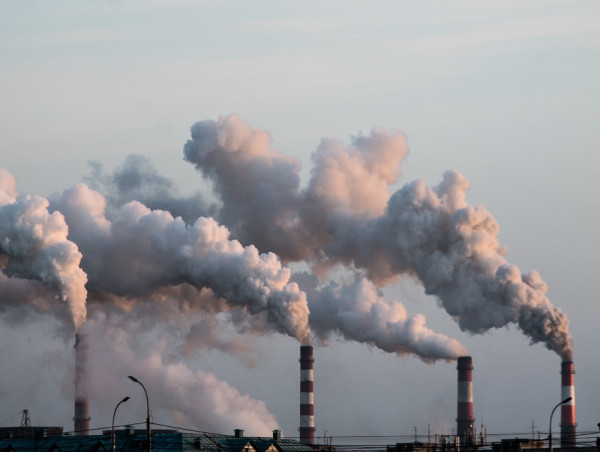In 2022, nearly half of all emissions in the United States originated from the industry and electric power sectors, primarily due to fossil fuel consumption for energy.
The Environmental Protection Agency identifies additional significant contributors, including personal and commercial transportation and agriculture.
Experts suggest that intensifying research into carbon capture and reducing emissions at the source could mitigate these effects.
However, industries responsible for high emissions often allocate only a small fraction of their revenues to research and development (R&D).

Source: Statista
Low R&D spending in high-emission industries
A study by the European Commission’s Economics of Industrial Research and Innovation project analyzed the R&D spending of the 2,500 companies with the highest expenditures in this area, calculating R&D intensity by dividing R&D costs by annual revenues for 2022.
The findings reveal a stark contrast in sector performance. For instance, oil and gas producers, including Chevron, Petrobras, and China Petroleum & Chemical, showed a median R&D intensity of just 0.3%.
The electricity sector, another significant emitter, had a slightly higher median R&D intensity of 0.8%.
Despite these modest figures, some companies invest heavily in researching new technologies, raising the mean R&D intensity in these sectors. Yet, overall, the spending is insufficient to drive substantial emission reductions.
The construction and materials sector, which involves energy-intensive processes such as cement manufacturing, demonstrated a median R&D intensity of 2.5%.
This is slightly above the European average R&D intensity of 2.2%, calculated as a share of GDP.
Automakers, amidst a transition towards greener alternatives like electric vehicles and hydrogen fuel, displayed higher R&D spending.
In 2022, seven of the top ten R&D investors were from the tech sector.
Companies like Alphabet, Meta, Microsoft, Apple, and Huawei invested between €21 billion and €37 billion each in R&D.
Volkswagen, Roche, and Johnson & Johnson completed the list with investments of €19 billion, €14 billion, and €14 billion, respectively.
The tech sector boasts the highest R&D intensity, with software and services at 20.7% and hardware and chips at 10%.
However, the extent to which their R&D efforts target emission reduction, particularly concerning the environmental impact of data centers and generative AI, remains uncertain.
Sectoral strategies for global emission reduction
Efforts to manage global emissions require cross-sectoral collaboration to mitigate environmental externalities effectively. In the transportation sector, key strategies include transitioning to electric vehicles and alternative fuels like hydrogen and biofuels, promoting sustainable mobility options, and implementing smart urban planning to reduce individual vehicle usage.
Similarly, in the energy sector, shifting to renewable energy sources such as solar and wind power, implementing energy efficiency measures in businesses and buildings, and deploying Carbon Capture and Storage (CCS) technology are critical steps towards reducing emissions.
Cross-sector collaboration emerges as a crucial strategy, with integrated solutions like renewable-powered electric vehicle charging infrastructure showing promise.
Optimizing supply chains for cleaner transportation modes and advocating for cross-sector policy alignment ensure consistency and effectiveness in emission-reduction efforts.
Technological advancements, such as R&D focused on smart grid systems and sustainable mobility options, along with digitalization and data analytics to optimize energy usage, offer innovative pathways to low-carbon technology.
Increasing public awareness of the environmental impact of transportation and energy choices through education campaigns empowers individuals to make more eco-conscious decisions.
Incentivizing sustainable behaviors, such as driving low-emission vehicles and using public transit, encourages shifts toward a greener future.
Latin America: Highly vulnerable to the impacts of climate change
While Latin America and the Caribbean account for only 11% of global emissions, the region is highly vulnerable to the impacts of climate change, necessitating concerted adaptation and resilience measures.
CAF’s latest Economics and Development Report, “Renewed Energies: Just Energy Transition for Sustainable Development,” offers a comprehensive analysis of the region’s energy landscape.
The report highlights the region’s potential contributions to the global energy transition, leveraging opportunities in key mineral reserves, gas supplies for transitional emission reduction, and renewable energy production capacities.
Sergio Díaz-Granados, CAF’s executive president, underscores the region’s ability to drive the global energy transition through critical decarbonization strategies outlined in the report.
These strategies include expanding electricity generation capacity from renewable sources, promoting low-emission fuels such as biofuels and hydrogen, and advocating for energy efficiency initiatives.
Finally, while some progress is being made, the current R&D spending in high-emission sectors is inadequate for achieving significant emission reductions. A concerted effort from both industry leaders and policymakers is essential to foster innovation and drive the transition toward a more sustainable future.
The post High-emission industries lag in R&D investment: Why it matters appeared first on Invezz





